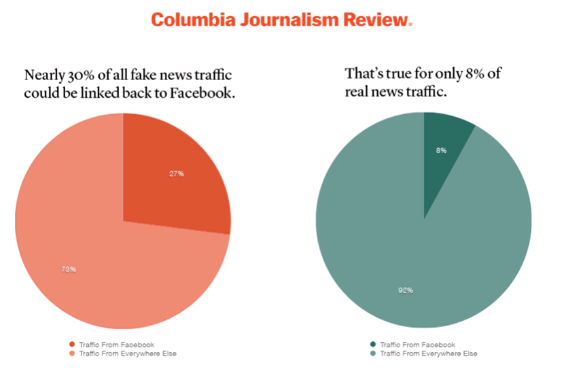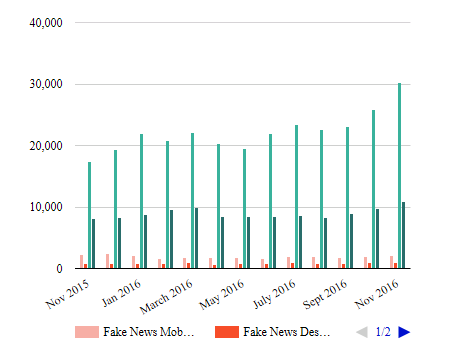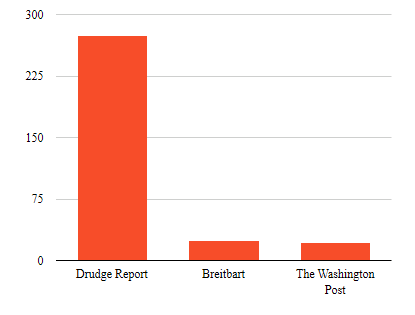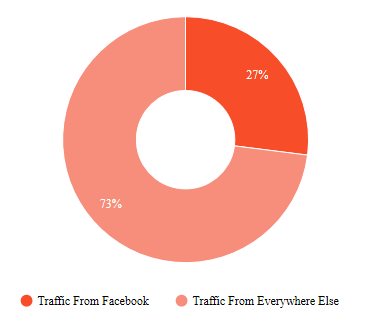Since the presidential election, “fake news” has become a buzzword leveraged by both sides of the political aisle, with many organizations directing resources toward understanding and fighting it.
Some efforts focus on improving technology: Facebook recently integrated fact-checking into its publication process, while Google no longer allows Google-served advertising to appear on sites that “misrepresent” information. Others focus on improving journalism: BuzzFeed Editor in Chief Ben Smith has advocated for more support for objective, accurate reporting as a way to counterbalance the fake news creeping its way across social media feeds.
What’s been missing from the conversation is a calculated look at fake news’s reach. We know little about the amount of fake news an average citizen consumes, or how it fits into their overall news diet. In fact, we don’t know much about the fake news audience, period. Are visitors to fake news sites in an echo chamber wherein they remain unexposed to conflicting information? Are they regularly consuming both fake and real news? How are audiences stumbling upon fake news? Without examining the audience, it’s impossible to know the scope of the problem.

As a PhD candidate researching journalism at Northwestern University’s Media, Technology, and Society program, I have spent the past few years using online audience data to better understand news consumption habits. Working with Northwestern Communication Studies Professor James G. Webster this fall, I used these data to take a closer look at the fake news audience. What we found calls into question the severity of the fake news crisis.
What we call ‘fake news’
As has become increasingly clear, “fake news” is neither straightforward nor easy to define. And so when we set out on this project, we referred to a list compiled by Melissa Zimdars, a media professor at Merrimack College in Massachusetts. The news sites on this list fall on a spectrum, which means that while some of the sites we examined* publish obviously inaccurate news (e.g., abcnews.com.co), others exist in a more ambiguous space, wherein they might publish some accurate information buried beneath misleading or distorted headlines (e.g., Drudge Report, Red State). Then there are intentionally satirical news sources, like The Onion and Clickhole. Our sample included examples of all of these types of fake news.
We also analyzed metrics for real news sites. That list represents a mix of 24 newspapers, broadcast, and digital-first publishers (e.g., Yahoo-ABC News, CNN, The New York Times, The Washington Post, Fox News, and BuzzFeed).
We gathered data for both the real and fake news sites from comScore, a Web analytic company that tracks online activity of about 1 million people within the US and then makes projections about the online behavior of the total US online audience.
Our analysis examined visitation (measured by unique visitors) and engagement (measured by average minutes per visitor) for real and fake news sites each month between November 2015 and November 2016. We used the averages of visits to and time spent with our real news and fake news samples to examine how real news consumption compared to fake news consumption, as well as how audiences for each changed over time. We chose November to November as our timespan because we were especially interested in observing if audience behavior changed leading up to and immediately following the election.
In addition to examining visitation and engagement, we also looked at the percentage of visitors to fake news sites who also visited real news sites, and the percentage of visits to both fake and real news sites that originated from Facebook. We looked at desktop and mobile online audiences, and found similar patterns across both platforms.
The fake news audience is real, but it’s also really small
Here’s what we found. First, the fake news audience is tiny compared to the real news audience–about 10 times smaller on average. This held true between November 2015 and November 2016. In fact, the real news audience spiked in October and November, while the fake news audience held constant.

Online news audiences spent more time on average with real news than fake news. The one exception was Drudge Report, which attracts an enormous amount of audience engagement as measured by average minutes per visitor. Take last November, for example. The average minutes-per-unique-visitor for Drudge Report clocked in at an astounding 275 minutes, 12 times higher than the same metric for The Washington Post and 11 times higher than it was for Breitbart.

Is fake news a fake problem?
Our findings call into question the scope of the fake news problem, while complicating the way we think about it. On the one hand, the fact that the fake news audience is small and highly likely to also visit real news sites may come as a relief to those who fear this audience lives in a separate, distorted reality. But exposure to news is one thing–how these audiences interpret the news is another. If half of the fake news audience had been approaching both real and fake news for the past year with an open mind, you would expect that audience to shrink as readers eventually abandoned fake news sites. That this has not happened suggests the fake news audience isn’t reading real news because they believe it might also be accurate, but because these sources are popular and they want to know how the rest of the world “falsely” understands current events. If this is indeed the case, it means solving the fake news problem will be much trickier than limiting its supply.

Would it be OK if I cross-posted this article to WriterBeat.com? I’ll be sure to give you complete credit as the author. There is no fee, I’m simply trying to add more content diversity for our community and I liked what you wrote. If “OK” please let me know via email.
Autumn
AutumnCote@WriterBeat.com
LikeLike